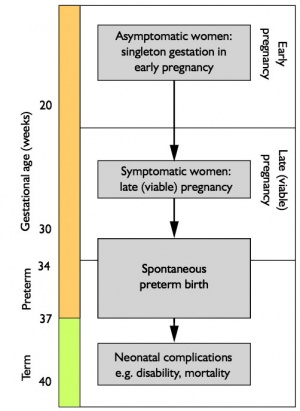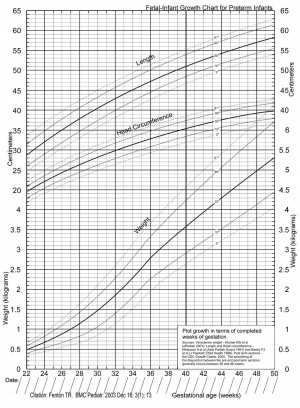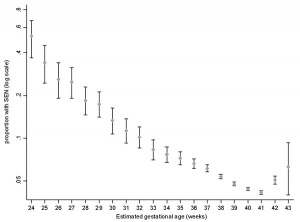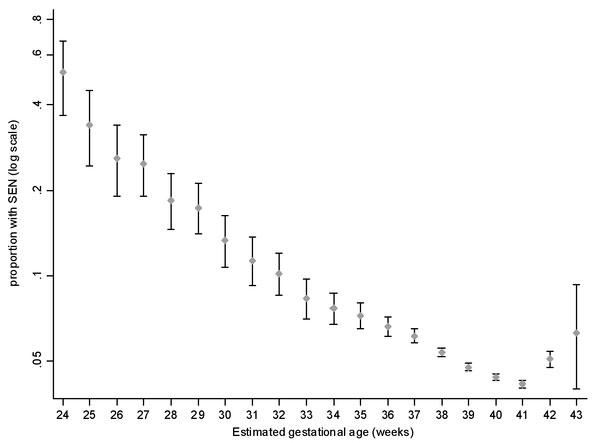Birth - Preterm: Difference between revisions
| Line 88: | Line 88: | ||
:'''Links:''' [http://consensus.nih.gov/2010/ino.htm NIH Consensus Development Conference: Inhaled Nitric Oxide Therapy for Premature Infants October 27-29, 2010] | :'''Links:''' [http://consensus.nih.gov/2010/ino.htm NIH Consensus Development Conference: Inhaled Nitric Oxide Therapy for Premature Infants October 27-29, 2010] | [http://consensus.nih.gov/2010/inofinalstatement.htm draft consensus statement] | ||
==References== | ==References== | ||
Revision as of 13:10, 27 March 2011
Introduction

In the USA the preterm birth rate declined in 2008 to 12.3 percent, from 12.8 percent in 2006. The preterm birth rates also declined from 2006 to 2008 for mothers of all age groups under age 40.[2]
- In the United States, more than 30,000 babies per year are born before the 28th week of pregnancy.
Some Recent Findings
|
Premature Birth
| Year | < 34 weeks % | 34-36 weeks % | total preterm % |
| 1990 | 3.3 | 7.3 | 10.6 |
| 1995 | 3.3 | 7.7 | 11 |
| 2000 | 3.4 | 8.2 | 11.6 |
| 2005 | 3.6 | 9.1 | 12.7 |
Data from: Prevention of preterm birth: a renewed national priority Damus K. Curr Opin Obstet Gynecol. 2008 Dec;20(6):590-6 PMID: 18989136
Growth Chart for Preterm Babies

- 1976 - the Babson and Benda "fetal-infant growth graph" for preterm infants was commonly used in neonatal intensive care.[7]
- 1996 - the Beeby graph based upon New South Wales Midwives Data Collection (MDC) from 1990 to 1994 inclusive (n = 422139).[8]
- 1999 - the National Institute of Child Health and Human Development Neonatal Research Network (NICHD) USA graph.[9]
- 2003 - improved version of the Babson and Benda graph based upon literature review and intrauterine data.[6]
Neural Development

A recent UK population-based study[10] "These findings show that gestational age at delivery strongly affects a child's subsequent risk of having an special educational need (SEN) in a dose-dependent manner across the whole range of gestational age. Furthermore, because early term delivery is much more common than preterm delivery, these findings show that early term delivery is responsible for more cases of SEN than preterm delivery."
Maternal Obesity
The following text information is from a recent systematic review and meta-analyses of maternal obesity[4]
What is already known on this topic
- The effect of overweight or obesity in women on risk of preterm birth is debated in the literature
- Uncertainty is reflected in national guidelines, although it is widely believed that the risk of having an infant of low birth weight is decreased in overweight or obese women
What this study adds
- Overweight or obese women have increased risks of preterm birth before 32 weeks and induced preterm birth before 37 weeks, and, accounting for publication bias, preterm birth before 37 weeks overall
- The beneficial effects of overweight or obesity on low birth weight were greater in developing than developed countries and disappeared after accounting for publication bias
- Overweight and obese women should be counselled before pregnancy on their perinatal risks, and appropriate surveillance should be considered during pregnancy
Inhaled Nitric Oxide Therapy
- Links: NIH Consensus Development Conference: Inhaled Nitric Oxide Therapy for Premature Infants October 27-29, 2010 | draft consensus statement
References
- ↑ 1.0 1.1 <pubmed>19796569</pubmed>
- ↑ NCHS Data Brief Number 39, May 2010
- ↑ <pubmed>20618921</pubmed>
- ↑ 4.0 4.1 <pubmed>20647282</pubmed>| BMJ
- ↑ <pubmed>20508778</pubmed>
- ↑ 6.0 6.1 <pubmed>14678563</pubmed>| BMC Pediatr.
- ↑ <pubmed>978333</pubmed>
- ↑ <pubmed>9007782</pubmed>
- ↑ <pubmed>10429008</pubmed>
- ↑ 10.0 10.1 <pubmed>20543995</pubmed>| PLoS Medicine
Search Pubmed
July 2010 "Preterm Birth" All (31665) Review (3598) Free Full Text (4781)
Search Pubmed: Preterm Birth
Glossary Links
- Glossary: A | B | C | D | E | F | G | H | I | J | K | L | M | N | O | P | Q | R | S | T | U | V | W | X | Y | Z | Numbers | Symbols | Term Link
Cite this page: Hill, M.A. (2024, April 27) Embryology Birth - Preterm. Retrieved from https://embryology.med.unsw.edu.au/embryology/index.php/Birth_-_Preterm
- © Dr Mark Hill 2024, UNSW Embryology ISBN: 978 0 7334 2609 4 - UNSW CRICOS Provider Code No. 00098G

